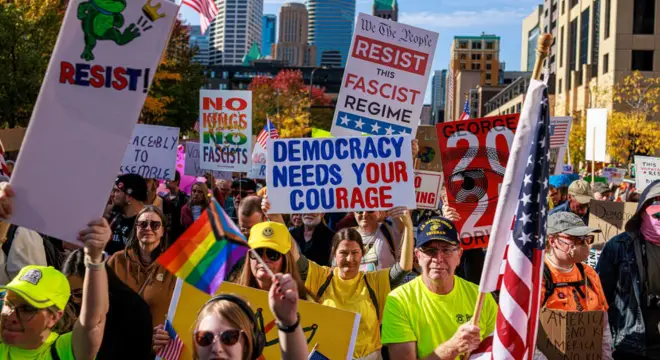On October 18, 2025, millions of Americans flooded city centers, town squares, and suburban parks for what became one of the largest political demonstrations in recent U.S. history—the nationwide No Kings protest 2025 .
Organized across 2,600 locations, the marches combined festive creativity with pointed political dissent. Brass bands blared beside handmade placards; families carried red-white-and-blue signs reading “We the People Rule.”
The event, framed as a “National Day of Democracy,” drew citizens from every age group and political background who shared a single conviction: opposition to any return of authoritarian governance. As one protester in Washington, D.C. shouted, “Nothing is more patriotic than protesting.”
II. Why the ‘No Kings’ Movement Began
The phrase “No Kings” surfaced early in Trump’s second term, poking fun at critics who asserted he led more like a monarch than an elected officeholder.
Grassroots groups used the phrase in rallies in spring 2025 to protest his dealings with billionaire Elon Musk over federal technology policy. When a government shutdown stretched beyond 18 days this October, frustration reignited nationwide.
Analysts trace the energy of “No Kings” to two historic precedents—the Women’s March of 2017 and the Civil Rights Movement of the 1960s—moments when ordinary Americans filled streets to reclaim civic power.
III. Scenes Across America
New York City’s Times Square transformed into a carnival of dissent. Tens of thousands chanted “Resist Fascism” while artists invited attendees to sign a 100-foot fabric replica of the U.S. Constitution. Street performers dressed as Lady Liberty and Uncle Sam danced under ticker-tape confetti.
In Washington, D.C., Marine veteran Shawn Howard told the crowd he had “fought extremism abroad” and was “seeing it rise at home.” Senator Bernie Sanders later declared from the stage, “We the people will rule—not one man, not one family.”
On the West Coast, Los Angeles marches mixed art and satire: theater students performed mock coronations of “King Trump I.” In Portland, protesters adopted inflatable frog costumes—a playful reclaiming of online symbols once tied to the far-right. Nightfall brought tension when ICE agents fired tear gas near a federal complex, dispersing crowds but causing no major injuries.
In the South and Midwest, turnout defied expectations. Birmingham, Alabama saw 1,500 people march past civil-rights landmarks singing gospel anthems. In Salt Lake City, roughly 3,500 demonstrators gathered peacefully in memory of a protester killed in June during a smaller immigration-rights rally.
IV. Voices of Protest — Ordinary Americans Speak Out
Many participants were first-time activists.
Hayley Wingard, wearing a Statue of Liberty costume in Chicago, said, “The military shouldn’t be in our cities. We can be safe without losing our freedom.”
In Atlanta, Jessica Yother, a mother of four, admitted, “It feels like an America I don’t recognize—but today I feel hope again.”
Sociologists note that such statements show a shift from partisan anger to civic anxiety—fear that democratic norms themselves are fragile. The crowd’s diversity—veterans, teachers, union workers, students—illustrated how wide that concern has spread.

V. Government & Political Reactions
President d downplayed the marches, telling reporters at a $1 million-per-plate fundraiser in Palm Beach that “people have a right to be wrong.”
Hours later, his campaign released a CGI video of “King Trump” sitting on a throne—intended as humor but fueling further outrage online.
Republican leaders branded the gatherings “Hate America rallies,” accusing Democrats of orchestrating chaos to distract from the ongoing shutdown.
In contrast, Democrats including Chuck Schumer, Bernie Sanders, and Chris Murphy issued statements praising the demonstrators for defending constitutional limits. Murphy wrote on X, “These aren’t mobs—they’re patriots reminding us that the presidency is not a crown.”
VI. Symbols and Meaning – Why “No Kings” Has Resonance
For historians, “No Kings” recalls the revolutionary impulse initiated in 1776 by the colonies’ rejection of monarchical rule. The revivification of the phrase seeks to link that legacy to present-day anxieties around executive abuse of power.
What set the 2025 movement apart was its humor and creative expression. Instead of aggression, protesters relied on satire, memes, and music—tools of non-violent resistance that spread faster online than any official statement.
Political theorist Dr. Elena Rivas from Georgetown University observed, “It’s rebellion with rhythm. They’re proving democracy can dance.”
VII. Numbers & Verified Facts
- 2,600 rallies nationwide, coordinated largely through Indivisible and MoveOn networks.
- Estimated turnout between 5 and 7 million people, according to organizers and local permits.
- Tens of thousands each in New York, Washington D.C., Los Angeles, and Portland.
- No major arrests reported in New York or D.C.; minor clashes in Portland.
- Participation spanned 50 states, including rural towns rarely seen in national protests.
- TikTok and YouTube livestreams reached over 80 million views in a single day.
These statistics identify No Kings 2025 as the largest organized public demonstration after the Women’s March 2017, suggesting a re- ignition of organized civic engagement.
VIII. Expert Commentary — The Reunification of the Democratic Base?
Political pundits argue that No Kings 2025 may represent a re-unification moment for the Democratic base that had been splintered after several months of discussion about economic policy and border issues.
Analyst Dr. Marcus Hill from the Brookings Institution stated that “street pressure and public sentiment could heavily influence the 2026 midterms.”
Non-partisan civic groups noted that beyond party lines, attendance included independents and libertarian-leaning conservatives alarmed by Trump’s emergency powers.
The scale and tone, experts say, prove that the language of democracy still motivates Americans more powerfully than partisan loyalty.
IX. Democracy Dancing Back
As darkness descended on October 18, fireworks lit up the National Mall and created the phrase “We the People.” Musicians drummed beats, and crowds sang “This Land Is Our Land.” It was a picture of the paradox of the day – joy wrapped in defiance.
Despite differing ideologies, participants shared one belief: that love of country includes the courage to question it.
A hand-painted banner in Seattle summarized the mood: “We’re not hating America—we’re fighting for its soul.”
The “No Kings Protest 2025” thus enters history not merely as an anti-Trump event but as a vivid reminder that democracy in the United States is a living, breathing conversation—one that sometimes takes to the streets to make itself heard.


